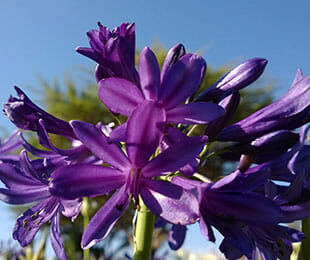Agapanthus Expanding Problems: Dirt, Sunlight, and Watering
Understanding the Art of Agapanthus Treatment: Vital Actions for Healthy And Balanced Growth and Vivid Blooms
In the realm of cultivation, the farming of agapanthus stands as a gratifying endeavor for those that seek to nurture these sophisticated flowering plants. From picking the appropriate selection to understanding pruning techniques, the trip in the direction of growing prospering agapanthus plants is complex and holds the key to opening the complete capacity of these botanical treasures.

Selecting the Right Agapanthus Selection

When selecting the ideal Agapanthus selection for your yard, think about factors such as climate viability, flower color, and development habit. Agapanthus, frequently known as Lily of the Nile or African lily, is available in a range of colors ranging from tones of purple and blue to white. Pick a bloom color that complements your existing yard palette to produce an unified landscape. In addition, take into consideration the climate in your area to guarantee the Agapanthus range you choose can grow in your details conditions. Some varieties are more tolerant of chilly temperatures, while others prefer warmer climates. Understanding the development routine of various Agapanthus varieties is critical for appropriate placement within your garden. Some selections have a clumping growth behavior, ideal for containers or borders, while others have an even more dispersing nature, appropriate for ground cover or mass growings. By very carefully examining these elements, you can choose the ideal Agapanthus variety to boost the elegance of your yard.
Suitable Planting Problems
Thinking about the optimal ecological demands is important for successful Agapanthus farming. Agapanthus grows in well-draining dirt with a slightly acidic to neutral pH degree. When planting, select a location that gets complete sunlight to partial color. In hotter environments, supplying some afternoon color can protect against scorching of the leaves. Agapanthus plants are sensitive to cool temperatures and need to be protected from frost during winter season.
To guarantee healthy growth and vivid blossoms, plant Agapanthus light bulbs at a deepness of concerning 2-4 inches and room them 8-12 inches apart. Mulching around the base of the plants helps keep wetness and reduces weed development.
Watering and Fertilizing Tips
Maintaining appropriate wetness degrees and providing necessary nutrients are crucial elements in the treatment routine for Agapanthus plants. When it comes to watering Agapanthus, it is important to strike a balance. These plants like regularly moist dirt yet are vulnerable to root rot if overwatered.
Feeding Agapanthus is essential for advertising healthy and balanced development and respected blooms. Apply a balanced plant food, such as a 10-10-10 formula, in the very early spring as brand-new development arises. By following these watering and fertilizing pointers, you can ensure your Agapanthus plants thrive and create vibrant, lasting flowers.
Pruning Methods for Agapanthus
Pruning Agapanthus plants at the ideal times and with proper methods is critical for maintaining their health and promoting optimal development and blooming. The suitable time to trim Agapanthus remains in late winter season or very early springtime before Click This Link new growth emerges. Start by removing any kind of yellowing or dead fallen leaves near the base of the plant. Cut them as short as possible without harming the arising shoots.
For flowered stems, wait up until the flowers have actually withered and after that cut them back to the base. This not only cleans the plant's appearance but also urges the advancement of new blossom buds. Deadheading spent flowers can likewise redirect the plant's energy right into producing more blossoms instead of setting seeds. However, if you want to collect seeds for proliferation, leave some flowers to dry and fully grown on the plant.
Bear in mind to utilize clean, sharp devices to make precise cuts and lower the risk of introducing conditions. Agapanthus. Regular pruning will certainly assist maintain your Agapanthus looking healthy and balanced and neat while making sure an abundant screen of lovely flowers
Managing Common Insects and Conditions
After making sure proper pruning methods for Agapanthus, it is vital to deal with usual pests and diseases that can impact the health and vitality of these plants. Agapanthus plants are usually sturdy however can still succumb to specific problems. One common insect that impacts Agapanthus is the Agapanthus gall midget. This small, orange fly lays its eggs in the vegetation, bring about altered growth and blossom buds that stop working to open. To fight this insect, trim and damage any kind of affected plant parts and think about utilizing insecticidal soap.
Furthermore, Agapanthus plants can endure from root rot if they are planted in badly draining news dirt. By being attentive and taking prompt activity versus illness and insects, you can help your Agapanthus plants flourish and create lively blooms. Agapanthus.

Conclusion
In final thought, understanding the art of agapanthus treatment includes selecting the appropriate variety, giving optimal planting conditions, proper watering and feeding, ideal pruning strategies, and attending to usual insects and conditions. By complying with these essential actions, you can make sure healthy and balanced development and vibrant blooms for your agapanthus plants. Remember to on a regular basis keep an eye on and maintain your plants to promote their general wellness and long life.
To guarantee healthy development and vibrant blooms, plant Agapanthus bulbs at a depth of concerning 2-4 inches and space them 8-12 inches apart. By complying with these watering and feeding tips, you can ensure your Agapanthus plants thrive and generate vibrant, lasting blooms.
One common bug that influences Agapanthus is the Agapanthus gall midget. Furthermore, Agapanthus plants can experience from origin rot if they are planted in badly draining pipes soil. By following these crucial actions, you can make sure healthy development and vibrant blooms try this out for your agapanthus plants.